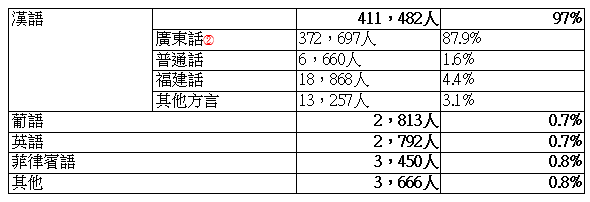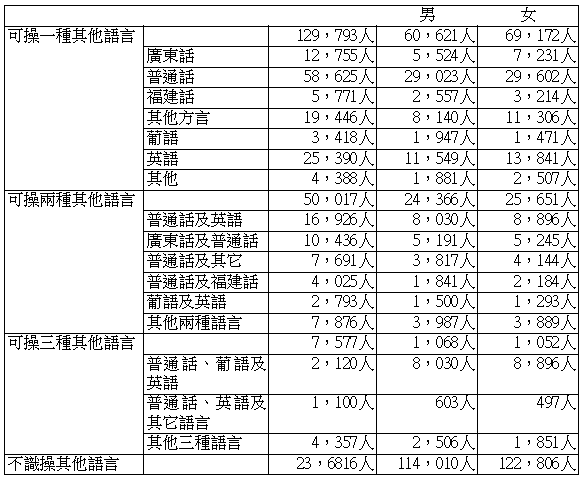|
新世紀的澳門語言策略
[摘要] 本文以2001年澳門人口普查的統計資料爲依據,詳細分析澳門的語言狀況,進而提出語文規劃。資料顯示,在不同的語種比較中,使用英語的人數增長最快最多;在漢語方言與普通話的比較中,普通話使用的人數增長遠遠超出人們的預料,尤其是在雙語結構中普通話的組合能力最強,由此決定推普工作和英語培訓必須加強。澳門語言問題集中在兩個方面:一是落實中文的官方地位,二是在澳門推行中葡雙語制。除此之外,還有英語的地位與社會對英語的需求等問題。本文從五個方面提出澳門的語言策略,要點是把澳門定位爲以旅遊博彩爲龍頭的文化城市,語言規劃要據此而展開。[關鍵字] 人口普查 官方語文 個人雙語 社會雙語 語文規劃
Macau’s Language Strategies in the New Century
Abstract: This paper uses the 2001 Macau census data in analyzing Macau’s language situation and makes some suggestions with respect to language planning. Data shows that the growth of the English-speaking population is the fastest and greatest amongst the different languages; also, the growth of Putonghua-speaking population is far more than expected when compared to other Chinese dialects and the frequency of Putonghua in bilingual combinations is the highest. Therefore, the work on popularizing Putonghua and on English training must be strengthened. Macau’s language problems have two main focuses: the first being the need to solidify the official status of Chinese, and the second being the execution of Chinese-Portuguese bilingualism in Macau. Moreover, the status of English and the social demand for English should also be considered. This paper discusses Macau’s language strategies from five angles, and argues that language planning must begin with the premise that Macau is a cultural city thriving on tourism and the gambling industry.Ching Chuengfai Keywords: Population census, official language, personal bilingualism, social bilingualism, language planning 一 制訂策略的依據 2002年4月初,政府公佈了2001年澳門人口普查的結果分析。其中與語言問題有關的資料有: 1. 結果摘要 日常用語,表七. 家中日常用語 二零零一人口普查統計簡表(人口社會特徵) 2. 統計表 表16:按堂區、日常用語言統計之3歲及以上居住人口數目① 表17:按堂區、其他可操語言及性別統計之3歲及以上居住人口數目 表19:按日常用語言、歲組及性別統計之3歲及以上居住人口數目 根據上述資料,可以得出以下結論: 1. 截至2001年8月下旬,澳門居住人口數目爲435,235人,其中3歲以上人口爲424,203人。居民分佈在陸上和水域,在水域生活的3歲以上人口 1,874人,有些資料的統計數位不能與人口總數完全相符(例如各項百分比相加不足100%),主要是沒有拿到水域人口的準確資料。因此,本文研究的物件是澳門3歲以上陸上人口的語言。 2. 人口出生地:    (责任编辑:admin) |
